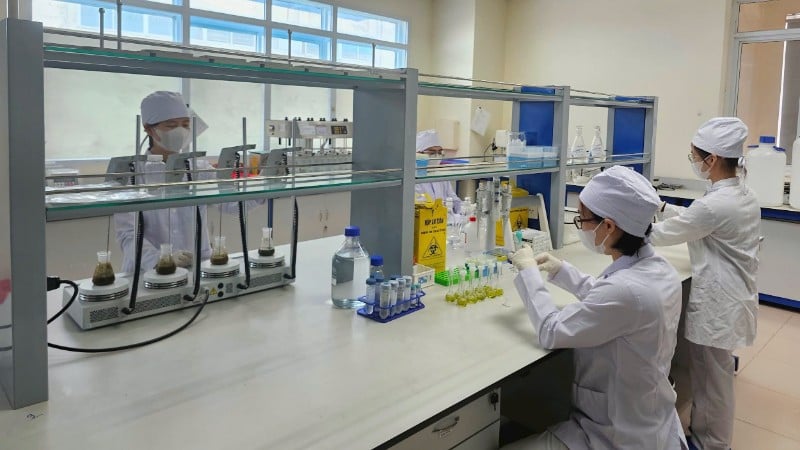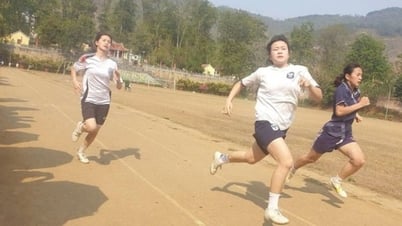
This reality requires improving the capacity of the testing system to proactively check and monitor drug quality, promptly detect counterfeit and poor quality drugs.
Testing work is still limited and inadequate.
The Vietnamese pharmaceutical market is growing with more than 23,000 drugs and more than 1,000 active ingredients licensed for circulation. According to the report of the Central Institute for Drug Control, currently, the entire drug testing system from central to local levels has about 2,085 employees, of which more than 1,700 are at the provincial level. This number is too small, when the units have to simultaneously supervise more than 300 pharmaceutical factories, 3,000 trading companies, 9,000 pharmacies and 12,000 drug stores.
The structure of staff doing testing work is also unbalanced, only about 25.3% of staff have a university degree; 60% of staff are under 40 years old, many people do not have in-depth testing experience, especially in advanced techniques such as: determining related impurities, analyzing extracted medicinal herbs, nano analysis...
Regarding equipment, many units (old provinces and cities) do not have enough of the three basic equipment to conduct drug testing including: high-performance liquid chromatography, UV-Vis spectrometer and dissolution tester. Other equipment such as gas chromatography-mass spectrometry, infrared spectrometer, atomic absorption spectrometer... are also not evenly equipped.
With a large and widespread number of testing units (62/63 provinces and cities before July 1, 2025) and the level of investment depending on each locality, it leads to a situation of small, overlapping, and ineffective investment; the level of human resources capacity and analytical equipment is only at a basic level, not meeting the requirements of modern testing to check and monitor the quality of high-tech drugs, biotechnology drugs, and specialized drugs...
Currently, the system is only capable of testing about 500 active ingredients out of a total of more than 1,000 new pharmaceutical active ingredients in circulation.
Notably, there is a serious shortage of standard substances for testing. Currently, the system is only capable of testing about 500 active ingredients out of more than 1,000 active ingredients of modern pharmaceuticals in circulation. Many drug samples must apply pharmacopoeia standards, which do not accurately reflect the criteria for registered products, and many samples are destroyed because there are no suitable testing standards.
For medicinal herbs, there is often no intact packaging, making it difficult to determine the origin, leading to the risk of mixing or counterfeiting. The testing system lacks extraction equipment, equipment to identify specific impurities, and lacks the budget to purchase standard substances extracted from medicinal herbs... All of the above difficulties make the current drug testing and inspection work unable to meet the practical management requirements.
One of the issues of concern is that the planning of the testing system of the Ministry of Health has not been completed up to now. There are no unified regulations on the legal status as well as the functions and tasks of testing units, especially at the provincial and municipal levels. The organizational system is fragmented, at the central level there are institutes, at the local level there are testing centers under the health department or merged into the disease control center. This lack of uniformity leads to difficulties in management, investment and building a long-term operating mechanism.
On the other hand, there is no unified regulation on the functions and tasks of provincial testing centers, which more or less slows down the progress of investment and upgrading the system. In addition, according to Circular 06/2011/TT-BYT of the Ministry of Health regulating the management of cosmetics, testing units have not been given the right to collect cosmetic samples, leading to the fact that many cosmetic businesses refuse to sign the sampling minutes when the inspection team comes to collect samples for quality testing. Meanwhile, the sampling staff of the testing system have not been granted a controller card, making it even more difficult to perform the function of market surveillance.
Strategic move
To improve the capacity of the system of drug, cosmetic and food testing facilities, the Ministry of Health is developing a project to plan the State testing system according to a two-level model: Central and local with 34 provincial testing centers after merging administrative boundaries. The two-level model is not simply a merger or a change in structure, but this is a strategic and key step, creating the foundation for building a modern, professional, and synchronous testing system, capable of detecting and controlling counterfeit and poor-quality drugs to ensure public health safety.
If the project is implemented synchronously with investment policies, human resource training and legal corridor improvement, this will be an important turning point to improve Vietnam's drug testing capacity in international integration.
The project aims to improve the quality of testing, inspection, and calibration of drugs, cosmetics, food, medical equipment, and environmental chemicals. According to the project, central-level drug testing facilities are reference laboratories, the highest level of technical expertise, meeting regional and international standards.
According to the project, central drug testing facilities are reference laboratories, the highest level of technical expertise, meeting regional and international standards.
The Central Institute for Drug Control is a unit with sufficient capacity to test chemical drugs, herbal drugs, traditional drugs; pharmaceutical ingredients, biological products, and biotechnology with therapeutic effects. The Ho Chi Minh City Institute for Drug Control is capable of testing chemical drugs, herbal drugs, traditional drugs; pharmaceutical ingredients; testing and verifying vaccines and biological products (priority is given to biological products and biotechnology with therapeutic effects). Provincial centers will be standardized according to GLP standards (good laboratory practices) and gradually achieve basic laboratory standards according to WHO standards.
An important point in the project is to expand the testing function for provincial centers. Accordingly, 34 provincial testing centers perform the function of testing, inspecting, and calibrating goods managed by the Ministry of Health, including cosmetics, food, medical equipment, and medical environments. Provincial testing centers have the capacity, basic professional qualifications, and meet the basic laboratory standards according to the guidelines of the World Health Organization, to analyze and test pharmaceutical chemicals, herbal medicines, traditional medicines, pharmaceutical ingredients, and some biotechnological drugs; and have additional appropriate equipment to analyze, inspect, inspect, and calibrate other goods managed by the Ministry of Health, including cosmetics, food, medical equipment, and medical environments.
According to Associate Professor, Dr. Doan Cao Son, Director of the Central Institute for Drug Testing, the project to plan a testing system that is streamlined, specialized, focused and multifunctionally integrated is a suitable and necessary step in the context of international integration.
If the project is implemented, by 2030, the State testing system will have the capacity to test and inspect 80% of pharmaceutical products, medicinal herbs, traditional medicines, pharmaceutical ingredients, vaccines used in the expanded immunization program, biological products and other goods under the management of the Ministry of Health. By 2050, the testing system will have the capacity to analyze 100% of products under the management of the Ministry of Health, including biological drugs, gene technology, advanced cell technology, etc.
Source: https://nhandan.vn/nang-cao-nang-luc-kiem-nghiem-thuoc-post897125.html































![[Photo] National Assembly Chairman attends the seminar "Building and operating an international financial center and recommendations for Vietnam"](https://vphoto.vietnam.vn/thumb/1200x675/vietnam/resource/IMAGE/2025/7/28/76393436936e457db31ec84433289f72)



































































Comment (0)